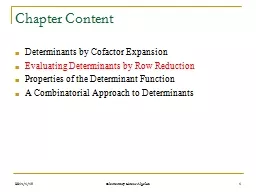

1 Chapter Content Determinants by Cofactor Expansion Evaluating Determinants by Row Reduction Properties of the Determinant Function A Combinatorial Approach to Determinants 2014119 Elementary Linear Algebra ID: 759473
Download Presentation The PPT/PDF document "2014/1/19 Elementary Linear Algebra" is the property of its rightful owner. Permission is granted to download and print the materials on this web site for personal, non-commercial use only, and to display it on your personal computer provided you do not modify the materials and that you retain all copyright notices contained in the materials. By downloading content from our website, you accept the terms of this agreement.
Slide1
2014/1/19
Elementary Linear Algebra
1
Chapter Content
Determinants by Cofactor Expansion
Evaluating Determinants by Row Reduction
Properties of the Determinant Function
A Combinatorial Approach to Determinants
Slide22014/1/19
Elementary Linear Algebra
2
Theorems
Theorem 2.2.1
Let
A
be a square matrix
If
A
has a row of zeros or a column of zeros, then det(
A
) = 0.
Theorem 2.2.2
Let
A
be a square matrix
det(
A
) = det(
A
T
)
Slide32014/1/19
Elementary Linear Algebra
3
Theorem 2.2.3 (Elementary Row Operations)
Let A be an nn matrixIf B is the matrix that results when a single row or single column of A is multiplied by a scalar k, than det(B) = k det(A)If B is the matrix that results when two rows or two columns of A are interchanged, then det(B) = - det(A)If B is the matrix that results when a multiple of one row of A is added to another row or when a multiple column is added to another column, then det(B) = det(A)Example 1
Slide42-2 Example of Theorem 2.2.3
2014/1/19
Elementary Linear Algebra
4
Slide52014/1/19
Elementary Linear Algebra
5
Theorem 2.2.4 (Elementary Matrices)
Let E be an nn elementary matrixIf E results from multiplying a row of In by k, then det(E) = kIf E results from interchanging two rows of In, then det(E) = -1If E results from adding a multiple of one row of In to another, then det(E) = 1Example 2
Slide6Theorem 2.2.5 (Matrices with Proportional Rows or Columns)
If A is a square matrix with two proportional rows or two proportional column, then det(A) = 0Example 3
2014/1/19
Elementary Linear Algebra
6
Slide72014/1/19
Elementary Linear Algebra
7
2-2 Example 4 (Using Row Reduction to Evaluate a Determinant)
Evaluate det(A) whereSolution:
The first and second rows of A are interchanged.
A common factor of 3 from the first row was taken through the determinant sign
Slide82014/1/19
Elementary Linear Algebra
8
2-2 Example 4 (continue)
-2 times the first row was added to the third row.
-10 times the second row was added to the third rowA common factor of -55 from the last row was taken through the determinant sign.
Slide92-2 Example 5
Using column operation to evaluate a determinant Compute the determinant of
2014/1/19
Elementary Linear Algebra
9
Slide102-2 Example 6
Row operations and cofactor expansionCompute the determinant of
2014/1/19
Elementary Linear Algebra
10